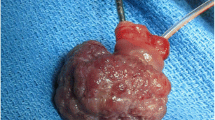Summary
Endoscopically placed biliary endoprostheses were used to treat obstructive jaundice in 71 patients with ampullary carcinoma. Successful placement of an endoprosthesis was achieved in 68 patients (95.8%). Bilirubin declined in 67 patients (98.5%). There was no procedure-related mortality. Twenty-two patients (31%) received further surgical therapy, and 47 received an endoprosthesis as their only therapeutic intervention. In the latter group, bilirubin normalized in 44 of 46 patients surviving longer than 30 days (95.7%). Mean survival was 466 days (median 410, range 23-1515), which compares favorably with surgical palliation. Complications mainly involved clogging of the endoprosthesis, which was easily treated endoscopically and, more significantly, duodenal stenoses secondary to continued tumor growth in almost 25% of the patients. Although endoscopic drainage is a safe and effective method of relieving biliary obstruction in patients with ampullary carcinoma, we feel it should be reserved for poor surgical candidates and for those patients with a limited life expectancy due to metastatic disease.
Similar content being viewed by others
References
Barton RM, Copeland EM (1983) Carcinoma of the ampulla of Vater. Surg Gynecol Obstet 156: 297–301
Crile G, Isbiter WH, Haink WA (1970) Carcinoma of the ampulla of Vater and the terminal bile and pancreatic ducts. Surg Gynecol Obstet 131: 1052–1054
Huibregtse K (1984) Techniques of endoscopic bile drainage. In: Classen M, Geenen J, Kawai K (eds) Nonsurgical biliary drainage. Springer, Berlin Heidelberg New York, pp 69–74
Huibregtse K, Tytgat GNJ (1982) Palliative treatment of obstructive jaundice by transpapillary introduction of a large bore bile duct endoprosthesis. Gut 23: 371–375
Huibregtse K, Haverkamp HJ, Tytgat GNJ (1981) Transpapillary positioning of a large 3.2 mm biliary endoprosthesis. Endoscopy 13: 217–219
Huibregtse K, Katon RM, Coene PP, Tytgat GNJ (1986) Endoscopic palliative treatment in pancreatic cancer. Gastrointest Endosc 32: 334–338
Knox RA, Kingston RD (1986) Carcinoma of the ampulla of Vater. Br J Surg 73: 72–73
Makipur H, Cooperman A, Donzi JT, Farmer RG (1976) Carcinoma of the ampulla: review of 38 cases with emphasis on treatment and prognostic factors. Ann Surg 183: 341–344
Nakase A, Matsumoto Y, Uchida K, Hongo J (1977) Surgical treatment of cancer of the pancreas and periampullary region: cumulative results in 57 institutions in Japan. Ann Surg 185: 52–57
Schlippert W, Lucke D, Anuras S, Christensen J (1978) Carcinoma of the papilla of Vater: a review of 57 cases. Am J Surg 135: 763–770
Walsh DB, Eckhauser FE, Cronenwatt JC, Turcotte JG, Lindauer SM (1982) Adenocarcinoma of the ampulla of Vater: diagnosis and treatment. Ann Surg 195: 152–157
Warren KW, Choe DS, Plaza J, Relihan M (1975) Results of radical resection for periampullary carcinoma. Ann Surg 181: 534–540
Author information
Authors and Affiliations
Rights and permissions
About this article
Cite this article
Huibregtse, K., Schneider, B., Rauws, E. et al. Carcinoma of the ampulla of vater. Surg Endosc 1, 79–82 (1987). https://doi.org/10.1007/BF00312688
Issue Date:
DOI: https://doi.org/10.1007/BF00312688




